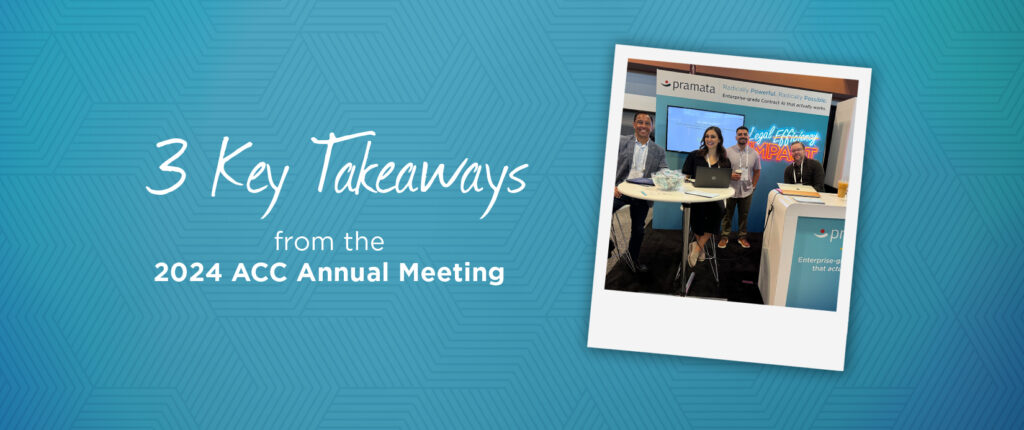Pramata was on the road this month, exhibiting at the ACC National Meeting in Nashville, Tennessee. These events are always eye-opening for me and the rest of our team, giving us a chance to speak directly to the legal professionals who are in the trenches managing their organizations’ CLM strategies.
Many of the conversations I had with attendees this year reinforced what we already know: Legal leaders are stressed! Budgets are being cut and legal departments are being downsized. Meanwhile, legal operations are constantly being challenged to add more value to the business without having access to effective tools that enable them to create more efficiencies across their workflow processes. As expected, generative AI—and its impact within the legal industry—was top of mind for all.
The conference sessions offered insights on everything from managing global IP portfolios to navigating internal investigations and handling internal disputes. But, overall, my primary takeaway from the conference is that it’s time for legal departments and in-house legal teams to focus more on strategy versus day-to-day tactical steps—easier said than done, I know.
Pramata’s Top 3 Takeaways from ACC
Takeaway #1. There is a massive opportunity for legal teams to rethink their roles – but most are too focused on cost and efficiency to do so.
A recurring theme when talking to attendees was centered around the fact that legal budgets are shrinking. At the same time, they are being challenged to deliver more—and different—value to the organization. Many attendees and vendors ‘quadrupled down’ on potential efficiency gains and cost savings, but a handful of legal execs I spoke with really leaned into finding new easy-to-add value and to protect their budget. In the contract management world, these business savvy legal leaders were looking beyond redlining to help find cost savings or revenue opportunities and empower cross-functional teams. With the impact of GenAI on legal only just beginning, we’re on a path towards legal teams either shrinking by 80% or adding 500% more value to the organization. Overall, the conference reflected this reality.
Takeaway #2. When it comes to GenAI solutions, there’s a lot of fluff with not nearly enough substance.
As I mentioned above, there were multiple discussions happening at every level—both in the technology demos and on the exhibitor floor—about generative AI and its impact on our industry. Unfortunately, the general consensus when talking to attendees is that the hype far exceeded the actual usefulness and value delivered. Even worse, there is a lot of “demoware” out there. We had one attendee comment, “Oh, I can actually trial your GenAI,” after having made the rounds on the exhibit hall. Another said, “My current CLM provider said GenAI isn’t on the roadmap anytime soon,” and a third said, “We have to wait ten minutes for the analysis to complete.” Add to this multiple discussions around proof of concepts that failed to show enough ROI to lead to purchases, and there are a lot of “interesting, but not useful” capabilities in the market.
In the CLM world, there is a lot of grandstanding, but few major players have released meaningful GenAI-powered production products. And even in the one area where there does seem to be more live products, like redlining, the feedback raises questions on usefulness and ROI. How useful is the output? How much more efficient will these products actually make lawyers? And will legal teams actually reduce in size to pay for these investments? We often challenge our customers to “think bigger” on ROI for these very reasons and I think the industry will continue to challenge vendors to do the same.
Takeaway #3. Our industry (CLM) still hasn’t solved the basics.
When asking attendees if they were happy with their CLM, the responses ranged from “meh” to “@%!#&.”
When asking why, a couple of things became clear. First, the whole presignature process (routing, approvals, templates, etc.) has been dramatically over-complicated and over-engineered. It took forever to go live and even then, adoption was minimal. Second, most people still did not have their contracts in one place or meaningful reporting and insight into what was in them—and this was years after deploying a CLM solution, and often, millions of dollars.
Compare that to what general counsels and chief legal officers need most from their CLM technology. The two most common responses we heard were, “We need tools that enable faster contract review processes,” and, “We need platforms that make it easy to keep all of our organization’s contracts organized and saved in a single location.” Now, these responses only underscore my first takeaway that the legal industry is overly focused on tactical steps versus big-picture strategy. But they also highlight the fact that our market still hasn’t solved these seemingly basic things. In fact, a majority of people I talked to that had a CLM either still weren’t live, or if they were, didn’t have legacy documents in the system!
The CLM Outlook: What’s to come for legal leaders
Taken together, these takeaways really point to significant disruption over the next few years. Legal teams will need to rethink their roles and push beyond the boundaries of “legal work” or they will continue to have budgets chipped away. Business savvy legal leaders will find some very compelling ways to leverage Generative AI to carve out this new role. Doing so will require teams to find innovative vendors and partners who can solve the basics while also helping them think beyond legal. In many cases, this will mean taking a more “best of breed” approach and curating a more fit-for-purpose tech stack vs a ‘one vendor for all’ mentality.
If you’re curious how Pramata can improve not only your day-to-day operations but enable you to become a vital part of the business, register to see our enterprise-grade contract AI in action: Schedule a demo now!



